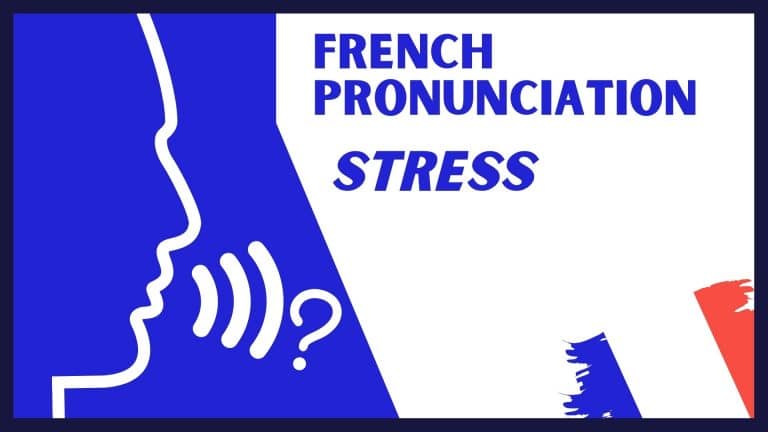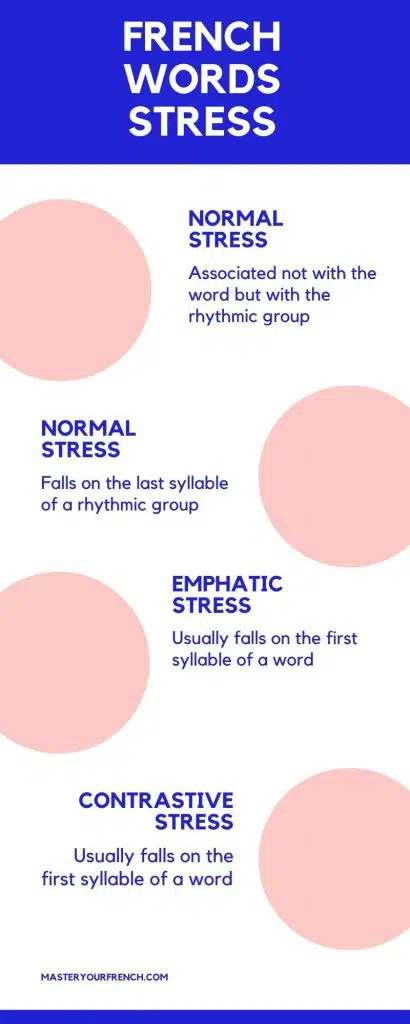French accentuation and stress
Updated: 8 June, 2023 by Mylene in Pronunciation Lessons ▪

Most languages employ mechanisms to highlight particular words or a group of words while speaking. Speakers tend to put more effort when pronouncing focus and informational words. These efforts vary between languages in terms of where the stress is realized, its length, and its intensity. Stress in the French language is located at the last full syllable of a word. All the other syllables in a word or in a phrase are not stressed in French. From a phonetic perspective and for the convenience of comparing French with other languages, French is a language with a fixed accent.
In this article, you will find out the right way to employ stress in a sentence when speaking French. In addition, we’ll go through the different types of stress in French with examples and exercises.
I will cover the following questions:
- Are French syllables stressed?
- How to use the tonic accent in French?
- Where is the stress in the French language?
- How to use the affective accent in French?
What’s accentuation in French?
French has a stress accent whenever a syllable in a word is given more emphasis. This phonetic prominence of a particular syllable is characterized by lengthening the last syllable of a word. Only the last word is accented in this example:
- Le chat
- Le petit chat
- Le très petit chat
- Le très petit chat maladroit
Are French syllables stressed?
Yes, there are two types of stress in French:
- the tonic accent: it allows to determine the rhythmic groups
- the affective accent: it allows to transmit an emotion
How to use the tonic accent in French?
The French tonic accent is placed at the end of a group of words. In fact, the French tonic accent is a group accent, not a word accent. In French, there is no variation in the place of the stress nor in their numbers.
But how to determine a group of words in French?
When you speak, you are delivering a message. A message is made up of groups of breath which constitute a complete unity of meaning: a sentence. A breath group can contain several rhythm groups. The voice rises at the end of each rhythm group: this is the intonation. These rhythmic groups constitute partial units of meaning.
The tonic emphasis is always placed on the last syllable of the rhythm group. This accentuation results in an elongation of the syllable.
Example: Elles ont diné hier soir à Dijon (They had dinner last night in Dijon).
There are three rhythmic groups and therefore three stressed syllables (in bold):
- elles ont diné
- hier soir
- à Dijon
How to determine rhythmic groups in French?
The rhythmic group usually has 2 to 4 syllables and up to a maximum of 9 syllables. Then you have to breathe to start a new rhythmic group. The stress has a demarcating function: it makes it possible to divide easily recognizable units of meaning. These units of meaning are the rhythmic groups. In general, rhythmic groups correspond to syntactic units (subject, verb, object complement, circumstantial complement, …).
- Elles ont diné hier soir à Dijon: there are 3 syntactic units and therefore 3 stressed syllables.
The emphasis is flexible and variable. The rhythmic groups can be cut in a very flexible way:
- Elles ont diné hier soir à Dijon: there are 2 syntactic units and therefore 2 stressed syllables.
- Elles ont diné hier soir à Dijon: there is 1 syntactic unit and therefore 1 stressed syllable.
Remember that there will be a maximum of 9 syllables. You must re-learn your breath!

Where is the stress in the French language?
The stress falls on the final syllable. In the case of the French tonic accent, the vowel in the final syllable is lengthened and stronger. Here are a few examples :
The syllable in bold is stronger and longer than all the other syllables.
How to use the affective accent in French?
The stress is placed on a syllable that is normally not stressed. The accentuation then translates into a feeling.
The stressed syllable is on average twice longer than the unstressed syllable.
Léon 1882
When you want to add stress to a word within a sentence, you have to isolate the word. The French affective accent does not replace the French tonic accent. In reality, it is added to the normal rhythm of the sentence. It can be used for:
- contrastive stress : ce n’est pas maintenant, c’est après
- emphatic stress : c’était génial
- differentiation (accent intellectuel) : des habits d’été, d’hiver
Once again, the French affective accent does not replace the tonic accent, however, is added to the normal rhythm of the sentence. The main emphasis is on the lengthening of the first or the second pronounced syllable.
Exercises
Try to pronounce these well-known words in French:
Find the French melody
The tonic accent and the affective accent are two elements which consist of variations of intensity and duration. Mastering these two accents is essential to get closer to the melody of French. Moreover, the intonation, that is to say the variation of the pitch of the voice is generally located on the same syllables as the accentuation.
Speak French better
Knowing the rules is the first step in your learning. You must now practice what you have just learned. But learning the pronunciation on your own can be very complicated. You need someone to point you out and explain where your mistakes are. And that’s where Master Your French dedicated program to teach the spoken language comes into play. To go beyond all your pronunciation difficulties in French book a study session to receive personalized advice.

